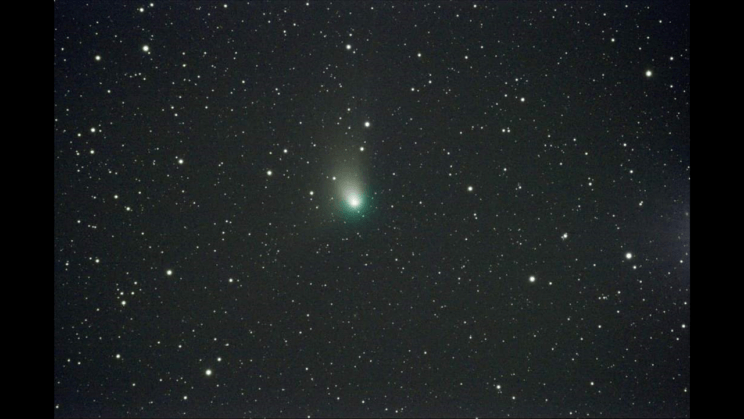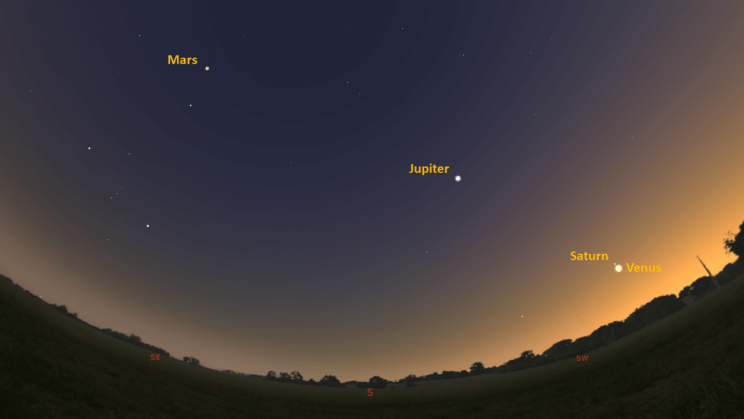This is the Saint Louis Science Center’s NIGHT SKY UPDATE for the week of Friday, January 20, 2023.
Information updated weekly or as needed.
Times given as local St. Louis time which is Central Standard Time (CST). For definitions of terminology used in the night sky update, click the highlighted text. If relying on times posted in Universal Time (UT), St. louis is -6 hours when CST.
Public Telescope Viewings
As part of the Saint Louis Science Center’s First Fridays, weather permitting, the St. Louis Astronomical Society and the Science Center will set up a number of telescopes outdoors and be on-hand to answer your questions. Telescope viewing begins once it is dark. Regardless of the weather on February 3, join us indoors in our planetarium theater for “The Sky Tonight”. Showtime is at 7 p.m.
Observing Highlight of the Week

Image of comet C/2022 E3 (ZTF) taken by Randy Harrison. The green color seen in the coma of the comet is caused by diatomic carbon. Image credit: Randy Harrison.
Our highlight this week will again be the comet C/2022 E3 (ZTF). Interest in this comet is increasing owing to several articles and news pieces beginning to make the rounds. Likely the rest of January and some of February will continue to focus on updates regarding C/2022 E3 (ZTF). If you would like to revisit past posts regarding the comet, they will stay posted on the Night Sky Update page of our website.
We are another week closer to when C/2022 E3 (ZTF) will be closest to Earth on February 1, 2023. The comet is continuing to brighten but new models are beginning to show it might peak at 6th magnitude. If this is the case, it will still be a nice comet to spot but likely will not be visible to the naked eye for most viewers. Comets are notorious for being fickle and not behaving as predictive models suggest.
If C/2022 E3 (ZTF) does not reach naked eye magnitude, it is still a nice target through binoculars. I last observed the comet around 4:00 a.m. on January 17, 2023 and would estimate its magnitude to be between 6.5 and 7.0. At low magnifications, C/2022 E3 (ZTF) looks much like a like a fuzzy ball with a bright core. Images of the comet show a wide fan like dust tail and a bright narrow ion tail. At low magnifications, the tail is not visible, but the comet looks a bit elongated. I have now seen C/2022 E3 (ZTF) through small binoculars (6×30), but to confirm it was the comet, I needed to be dark adapted. That said, anyone that has binoculars at home should be able to spot the comet.
This week, C/2022 E3 (ZTF) becomes circumpolar. At the start of the week, there is a small window of time were the comet hangs just below the horizon. It will clear most tree lines by 11:00 p.m. and should be easy to spot by midnight. The comet begins the week in the constellation Boötes. Later it moves into Draco, and it ends the weeks in Ursa Minor. By January 26, 2023, C/2022 E3 (ZTF) will be visible at any time of the evening. It will still be best seen after midnight as it climbs higher above the northern horizon.
After the comet’s closest approach to Earth on February 1, 2023, C/2022 E3 (ZTF) will shift into to being best viewed in the early evening. During this time, we will see the comet visit Mars in the sky as it passes through Taurus. The best dates for this are February 10 and 11.
Even though C/2022 E3 (ZTF) appears to be underperforming from early models, it is still a fine target. It still could improve over the next few weeks, but it is looking to remain a binocular target for most. It is not often we get comets that are also good targets for urban viewing so take advantage while we can. As always, I recommend the software Stellarium and the Comet Chasing website for information regarding the location of the comet.
The Sun and Moon

The Moon as seen from the International Space Station, on July 31, 2011.
Credit: NASA
Sunrise is at 7:15 a.m. on Friday, January 20 and sunset is at 5:09 p.m. providing us with roughly 10 hours of daylight. Even after sunset, light from the Sun will dimly illuminate our sky for roughly 1 hour and 30 minutes. This period is called twilight, which ends around 6:42 p.m. this week. For those with a sundial, local noon occurs around 12:11 p.m. this week.
| Day | Sunrise | Sunset | ||||||||||
|---|---|---|---|---|---|---|---|---|---|---|---|---|
| 20-Jan | 7:15 a.m. | 5:09 p.m. | ||||||||||
| 21-Jan | 7:14 a.m. | 5:10 p.m. | ||||||||||
| 22-Jan | 7:14 a.m. | 5:11 p.m. | ||||||||||
| 23-Jan | 7:13 a.m. | 5:12 p.m. | ||||||||||
| 24-Jan | 7:13 a.m. | 5:13 p.m. | ||||||||||
| 25-Jan | 7:12 a.m. | 5:14 p.m. | ||||||||||
| 26-Jan | 7:11 a.m. | 5:16 p.m. | ||||||||||
| 27-Jan | 7:11 a.m. | 5:17 p.m. | ||||||||||
| 28-Jan | 7:10 a.m. | 5:18 p.m. |
Moon
Moonrise for Friday, January 20 was at 6:31 p.m. and moonset occurred at 3:39 p.m. Friday, January 20, the Moon will exhibit a waning crescent phase with 1% of the lunar disk illuminated. New moon occurs on January 21, 2023, at 2:53 p.m.
International Space Station (ISS) Observing

There are several visible passes of ISS from St. Louis for the week of January 20. They occur during evening hours. The best passes for this week are listed below. Use the table below for information about these passes.
Catch ISS from St. Louis starting Friday, January 20
| Date | Starts | Max. altitude | Ends | |||||||
|---|---|---|---|---|---|---|---|---|---|---|
| Time | Alt. | Az. | Time | Alt. | Az. | Time | Alt. | Az. | ||
| 21 Jan | -1.3 | 18:31:52 | 10 | NW | 18:33:52 | 15 | NNW | 18:35:15 | 12 | N |
| 22 Jan | -1.6 | 17:42:45 | 10 | WNW | 17:45:17 | 19 | NNW | 17:47:48 | 10 | NNE |
Magnitude (Mag): The Measure of brightness for a celestial object. The lower the value is, the brighter the object will be.
Altitude (Alt): The angle of a celestial object measured upwards from the observer’s horizon.
Azimuth (Az): The direction of a celestial object, measured clockwise from an observer’s location with north being 0°, east being 90°, south being 180° and west being 270°.
For information about ISS flyovers and other visible satellites, visit www.heavens-above.com
Detailed information regarding all unmanned exploration of our universe, missions past, present, and planned, can be found at Jet Propulsion Laboratories:
The Visible Planets

Looking south at 5:40 p.m. on January 21, 2023. Credit: Stellarium, EG
This week, four naked eye planets are visible. Mars is high in the east after sunset. Jupiter and Saturn rise before sunset and will be visible once it is dark. Venus is visible in the west about 20 minutes after sunset.
Venus
Venus is climbing out of the Sun’s glare as it starts another an evening apparition. Once high enough above the horizon, Venus will be a bright target in the west after sunset until August 2023 when it approaches inferior conjunction. This week, look for Venus in the southwest about 20 minutes after sunset.
Mars
Mars now rises before sunset becoming visible once it is dark. Look for it in the east about 30 minutes after sunset. Mars sets by 3:48 a.m.
Jupiter
Now past opposition, Jupiter will be visible about 30 minutes after sunset. Jupiter reaches superior conjunction on April 11, 2023. As we progress towards this date, we will see Jupiter slowly wander towards the Sun. Jupiter now sets at 10:14 p.m.
Saturn
Now past opposition, Saturn rises before the Sun sets. You can find this giant world in the southwest about 30 minutes after sunset. Saturn will soon be lost to the Sun’s glare as it approaches superior conjunction on February 16, 2023. Saturn sets by 6:57 p.m.
James S. McDonnell Planetarium
Night Sky Update: January 30 – 28, 2023






